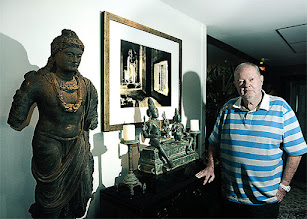 |
| Douglas Latchford in his London home (export licences?) |
Douglas Latchford, a central character in a long-going case of antiquities smuggling has died, aged 89 in Bangkok. He was a leading dealer in the trade in Cambodian art in the 1970s, but last year was accused of allegedly creating false provenances for antiquities. The Art Newspaper article covering this story (Vincent Noce, ' 'Adventurer scholar' Douglas Latchford dies in Bangkok, aged 89' The Art Newspaper 10th August 2020 ) shows how embedded colonialism is in today's art market.
A self-described "adventurer scholar", Douglas Latchford was born in Bombay (now present day Mumbai) to British parents. He settled in Thailand in 1951, where he became successful in the pharmaceutical and property businesses, before running body-building competitions. He was himself a large man, who took pleasure in telling journalists visiting his house full of statues of Buddha and Siamese or Burmese gods, how he became interested in South-Eastern art while travelling dirt roads in Thailand and Cambodia to explore fabulous ruins and local antiquities’ markets. Latchford built a reputation as a world expert in Khmer antiquities, co-writing three reference books with the American academic Emma Bunker. In the 1970s he became one of the most prominent suppliers of Cambodian art to museums and collectors in the US and Europe, notably through Spink’s in London. [...] In 2010, Latchford told the Bangkok Post that “most of the pieces he has come across have been found and dug up by farmers in fields”. He liked to see himself as a rescuer of works of art which were long abandoned and might have been destroyed in Cambodia’s civil wars.Latchford was mixed up in the sale of a number of statues from the Khmer capital Koh Ker that ended up in US museums like the Metropolitan and the Norton Collection. These have in the past decade now been identified as stolen and been returned to Cambodia. Once attention was on the topic, another item being sold by Sotheby's was withdrawn from sale and returned to Cambodia. Yet it was only in November last year that a New York District Attorney announced the indictment of Douglas Latchford for alleged the smuggling and trafficking into the US of stolen and looted Cambodian antiquities. If these charges had come to court, it would have shown the degree to which he was a foreign war profiteer who trafficked in "blood antiquities" and capitalized on destabilisation and genocide. The Art newspaper article tries to make the issue merely one of incorrect paperwork.
Latchford always denied any wrongdoing and any involvement in smuggling. “His collection was substantially put together long before cultural heritage laws were introduced. The world was very different in those days, it is wrong to perceive his actions solely through a 2020s’ lens", a close friend of Latchford tells The Art Newspaper, adding that "without the passion and attention of people like him, vital objects would have been lost to the world".
That's what they all say. we will see what happens to his private collection, whether those objects and the information about their findspots will be saved for the world. There were laws in place, he just ignored them.









No comments:
Post a Comment